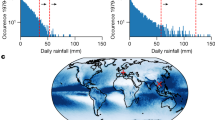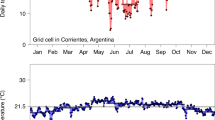Abstract
Extreme weather events are expected to increase with climate change. Such events are detrimental for local economic activity but could also affect countries that are not directly exposed through global agricultural production shortfalls and price surges. Here, estimations for 75 countries show that increases in global agricultural commodity prices caused by harvest or weather disruptions in other regions of the world significantly curtail economic activity. The impact is considerably stronger in advanced countries, despite relatively lower shares of food in household expenditures. Effects are weaker when countries are net exporters of agricultural products, have large agricultural sectors and/or are less integrated in global markets for non-agricultural trade. Once we control for these characteristics, the relationship between the country’s income per capita and the economic repercussions becomes negative. Overall, these findings suggest that the consequences of climate change on advanced countries, particularly through food prices, may be larger than previously thought.
This is a preview of subscription content, access via your institution
Access options
Access Nature and 54 other Nature Portfolio journals
Get Nature+, our best-value online-access subscription
$29.99 / 30 days
cancel any time
Subscribe to this journal
Receive 12 print issues and online access
$209.00 per year
only $17.42 per issue
Buy this article
- Purchase on Springer Link
- Instant access to full article PDF
Prices may be subject to local taxes which are calculated during checkout






Similar content being viewed by others
Data availability
The datasets used for this paper are available at: https://doi.org/10.5281/zenodo.4665886.
Code availability
The codes to reproduce the results of the paper are available at: https://doi.org/10.5281/zenodo.4665886.
References
Munasinghe, L., Jun, T. & Rind, D. Climate Change: a new metric to measure changes in the frequency of extreme temperatures using record data. Climatic Change 113, 1001–1024 (2012).
Hansen, J., Sato, M. & Ruedy, R. Perception of climate change. Proc. Natl Acad. Sci. USA 109, E2415–E2423 (2012).
Coumou, D. & Rahmstorf, S. A decade of weather extremes. Nat. Clim. Change 2, 491–496 (2012).
IPCC Climate Change 2014: Synthesis Report (eds Core Writing Team, Pachauri, R. K. & Meyer L. A.) (IPCC, 2014).
IPCC 2019 Refinement to the 2006 IPCC Guidelines for National Greenhouse Gas Inventories (eds Calvo Buendia, E. et al.) (IPCC, 2019).
Rosenzweig, C. & Parry, M. Potential impact of climate change on world food supply. Nature 367, 133–138 (1994).
Nordhaus, W. D. Geography and macroeconomics: new data and new findings. Proc. Natl Acad. Sci. USA 103, 3510–3517 (2006).
Mendelsohn, R. The impact of climate change on agriculture in developing countries. J. Nat. Resour. Pol. Res. 1, 5–19 (2008).
Dell, Melissa, Jones, B. F. & Olken, B. A. Temperature shocks and economic growth: evidence from the last half century. Am. Econ. J. Macroecon. 4, 66–95 (2012).
Carleton, T. A. & Hsiang, S. M. Social and economic impacts of climate. Science 353, aad9837 (2016).
Liu, B. et al. Similar estimates of temperature impacts on global wheat yield independent methods. Nat. Clim. Change 6, 1130–1136 (2016).
Barriopedro, D., Fischer, E., Luterbacher, J., Trigo, R. & Garcia-Herrera, R. The hot 37 summer of 2010: redrawing the temperature record map of Europe. Science 332, 220–224 (2011).
Hoag, H. Russian summer tops universal heatwave index. Nat. News https://doi.org/10.1038/nature.2014.16250 (2014).
De Winne, J. & Peersman, G. The macroeconomic effects of disruptions in global food commodity markets: evidence for the United States. Brook. Pap. Econ. Act. 47, 183–286 (2016).
Lesk, C., Rowhani, P. & Ramankutty, N. Influence of extreme weather disasters on global crop production. Nature 529, 84–87 (2016).
Bailey, R. et al. Extreme Weather and Resilience of the Global Food System (The Global Food Security, 2015).
Battisti, D. & Naylor, R. Historical warnings of future food insecurity with unprecedented seasonal heat. Science 323, 240–244 (2009).
Asseng, S. et al. Rising temperatures reduce global wheat production. Nat. Clim. Change 5, 143–147 (2015).
Hasegawa, T. et al. Risk of increase food insecurity under stringent global climate change mitigation policy. Nat. Clim. Change 8, 699–703 (2018).
Tigchelaar, M., Battisti, D., Naylor, R. & Ray, D. Future warming increases probability of globally synchronized maize production shocks. Proc. Natl Acad. Sci. USA 115, 6644–6649 (2018).
Addison, T., Ghoshray, A. & Stamatogiannis, M. P. Agricultural commodity price shocks and their effect on growth in Sub-Saharan Africa. J. Agric. Econ. 67, 47–61 (2016).
Dreschel, T. & Tenreyro, S. Commodity Booms and Busts in Emerging Economics (NBER, 2017).
Fernandez, A., Schmitt-Grohe, S. & Uribe, M. World shocks, world prices, and business cycles: an empirical investigation. J. Int. Econ. 108, S2–S14 (2017).
Headey, D. & Fan, S. Anatomy of a crisis: the causes and consequences of surging food prices. Agric. Econ. 39, 375–391 (2008).
Abbott, P. C., Hurt, C. & Tyner, W. E. What’s Driving Food Prices in 2011? (Farm Foundation, 2011).
Stock, J. H. & Watson, M. W. Disentangling the channels of the 2007–2009 recession. Brook. Pap. Econ. Act. 43, 81–156 (2012).
Mertens, K. & Ravn, M. O. The dynamic effects of personal and corporate income tax changes in the United States. Am. Econ. Rev. 103, 1212–1247 (2013).
Jordà, Ò. Estimation and inference of impulse responses by local projections. Am. Econ. Rev. 95, 161–182 (2005).
Bernanke, B. S., Gertler, M. & Gilchrist, S. in Handbook of Macroeconomics (eds Taylor, J. B. & Woodford, M.) 1341–1393 (Elsevier, 1999).
Christiano, L., Eichenbaum, M. & Evans, C. Nominal rigidities and the dynamic effects of a shock to monetary policy. J. Political Econ. 113, 1–45 (2005).
Smets, F. & Wouters, R. Shocks and frictions in US business cycles: a Bayesian DSGE approach. Am. Econ. Rev. 97, 586–606 (2007).
Ezekiel, M. The Cobweb Theorem. Q. J. Econ. 52, 255–280 (1938).
Glauber J. W. & Miranda M. J. in Food Price Volatility and Its Implications for Food Security and Policy (eds Kalkuhl M. et al.) 83–100 (Springer, 2016).
Muth, J. Rational expectations and the theory of price movements. Econometrica 29, 315–335 (1961).
World Economic Outlook Database—WEO Groups and Aggregates (International Monetary Fund, 2021); https://www.imf.org/external/pubs/
De Winne, J. & Peersman, G. The impact of food prices on conflict revisited. J. Bus. Econ. Stat. 39, 547–560 (2021).
Denizer, C. A., Iyigun, M. F. & Owen, A. Finance and macroeconomic volatility. BE J. Macroecon. 2, 7 (2002).
Dynan, K. E., Elmendorf, D. W. & Sichel, D. E. Can financial innovation help to explain the reduced volatility of economic activity? J. Monet. Econ. 53, 123–150 (2006).
Di Pace, F., Juvenal, L. & Petrella, I. Terms-of-Trade Shocks are Not all Alike (IMF, 2020).
Cudjoe, G., Breisinger, C. & Diao, X. Local impacts of a global crisis: food price transmission, consumer welfare and poverty in Ghana. Food Policy 35, 294–330 (2010).
Clark, T. E. & Van Wincoop, E. Borders and business cycles. J. Int. Econ. 55, 59–85 (2001).
Calderón, C., Chong, A. & Stein, E. Trade intensity and business cycle synchronization: are developing countries any different? J. Int. Econ. 71, 2–21 (2007).
di Giovanni, J. & Levchenko, A. Trade openness and volatility. Rev. Econ. Stat. 91, 558–585 (2009).
Althor, G., Watson, J. & Fuller, R. A. Global mismatch between greenhouse gas emissions and the burden of climate change. Sci. Rep. 6, 20281 (2016).
Woodford, M. Interest and Prices: Foundations of a Theory of Monetary Policy 381–626 (Princeton Univ. Press, 2003).
Swinnen, J. & Squicciarini, P. Mixed messages on prices and food security. Science 335, 405–406 (2012).
Aksoy, M. A. & Isik-Dikmelik, A. Are Low Food Prices Pro-Poor? Net Food Buyers and Sellers in Low-Income Countries (World Bank, 2008).
Ivanic, M. & Martin, W. Implications of higher global food prices for poverty in low-income countries. Agric. Econ. 39, 405–416 (2008).
Ivanic, M. & Martin, W. Short-and Long-Run Impacts of Food Price Changes on Poverty (World Bank, 2014).
Verpoorten, M., Arora, A., Stoop, N. & Swinnen, J. Self-reported food insecurity in Africa during the food price crisis. Food Policy 39, 51–63 (2013).
Jacoby, H. G. Food prices, wages, and welfare in rural India. Econ. Inq. 54, 159–176 (2016).
Sims, C. A. Macroeconomics and reality. Econometrica 48, 1–48 (1980).
Roberts, M. J. & Schlenker, W. Identifying supply and demand elasticities of agricultural commodities: implications for the US ethanol mandate. Am. Econ. Rev. 103, 2265–2295 (2013).
IMF Primary Commodity Prices (IMF, 2021); https://data.imf.org
Peersman, G. International food commodity prices and missing (dis)inflation in the Euro area. Rev. Econ. Stat. (in the press).
Ramey, V. A. Macroeconomic Shocks and Their Propagation (NBER, 2016).
Sims, C. A., Stock, J. H. & Watson, M. W. Inference in linear time series models with some unit roots. Econometrica 58, 113–144 (1990).
Elliott, G. On the robustness of cointegration methods when regressors almost have unit roots. Econometrica 66, 149–158 (1998).
Mertens, K. & Ravn, M. O. The dynamic effects of personal and corporate income tax changes in the United States: reply. Am. Econ. Rev. 109, 2679–2691 (2019).
Boeckx, J., De Sola Perea, M. & Peersman, G. The transmission mechanism of credit support policies in the Euro area. Eur. Econ. Rev. http://hdl.handle.net/1854/LU-8648836 (2020).
Pesaran, M. H., Shin, Y. & Smith, R. P. Pooled mean group estimation of dynamic heterogeneous panels. J. Am. Stat. Assoc. 94, 621–634 (1999).
Thompson, S. B. Simple formulas for standard errors that cluster by both firm and time. J. Financ. Econ. 99, 1–10 (2011).
Schmitt, M. A., Lamb, J. A., Randall, G. W., Orf, J. M. & Rehm, G. W. In-season fertilizer nitrogen applications for soybean in Minnesota. Agron. J. 93, 983–988 (2001).
Scharf, P. C., Wiebold, W. J. & Lory, J. A. Corn yield response to nitrogen fertilizer timing and deficiency level. Agron. J. 94, 435–441 (2002).
Pindyck, R. S. The present value model of rational commodity pricing. Econ. J. 103, 511–530 (1993).
Deaton, A. & Laroque, G. On the behaviour of commodity prices. Rev. Econ. Stud. 59, 1–23 (1992).
Wright, B. Global biofuels: key to the puzzle of grain market behavior. J. Econ. Perspect. 28, 73–98 (2014).
Mendelsohn, R., Nordhaus, W. D. & Shaw, D. The impact of global warming on agriculture: a Ricardian analysis. Am. Econ. Rev. 84, 753–771 (1994).
Harris, I., Jones, P. & Osborn, T. CRU TS4.04: Climatic Research Unit (CRU) Time-Series (TS) Version 4.04 of High-Resolution Gridded Data of Month-by-Month Variation in Climate (Jan. 1901–Dec. 2019) (CEDA, 2020); https://catalogue.ceda.ac.uk/uuid/89e1e34ec3554dc98594a5732622bce9
Monfreda, C., Ramankutty, N. & Foley, J. Farming the planet: 2. Geographic distribution of crop area, yield, physiological types, and net primary production in the year 2000. Glob. Biogeochem. Cycles 22, GB1022 (2008).
Sacks, W., Deryng, D., Foley, J. & Ramankutty, N. Crop planting dates: an analysis of global patterns. Glob. Ecol. Biogeogr. 19, 607–620 (2010).
Acknowledgements
We acknowledge financial support from The Research Foundation Flanders (FWO), grant no. G020713N (G.P.). The UGent Special Research Fund (BOF) provided PhD scholarship for J.DeW.
Author information
Authors and Affiliations
Contributions
Both authors have made substantial contributions to all aspects of the paper.
Corresponding author
Ethics declarations
Competing interests
The authors declare no competing interests.
Additional information
Peer review information Nature Climate Change thanks Andrea Guariso, Will Martin and the other, anonymous, reviewer(s) for their contribution to the peer review of this work.
Publisher’s note Springer Nature remains neutral with regard to jurisdictional claims in published maps and institutional affiliations.
Supplementary information
Supplementary Information
Supplementary discussion, Tables 1–4 and Figs. 1–13.
Rights and permissions
About this article
Cite this article
De Winne, J., Peersman, G. The adverse consequences of global harvest and weather disruptions on economic activity. Nat. Clim. Chang. 11, 665–672 (2021). https://doi.org/10.1038/s41558-021-01102-w
Received:
Accepted:
Published:
Issue Date:
DOI: https://doi.org/10.1038/s41558-021-01102-w
This article is cited by
-
Thermal Modeling of Geosynthetics and Earth Structures in a Changing Climate: Overview and Future Challenges
International Journal of Geosynthetics and Ground Engineering (2024)
-
How does tourism affect the urban heat island effect? A case study of the tourism heat footprint in Macao
Environment, Development and Sustainability (2023)



